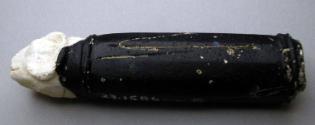Cameo Glass Trulla Handle with Ram's Head Terminal
Cameo Glass Trulla Handle with Ram's Head Terminal
Place of OriginItaly, likely Rome or Bay of Naples
Dateabout 15 BCE - 25 CE (Roman, Augustan)
DimensionsL: 4 1/4 in. (10.7 cm); W: 1 in. (2.5 cm)
MediumCameo glass
ClassificationGlass
Credit LineGift of Edward Drummond Libbey
Object number
1923.1586
Not on View
DescriptionTwelve-sided, rod-like handle, originally part of a trulla (a small saucepan), made from dark glass. The end features a naturalistic cameo-cut ram's head in opaque white glass. Details include protruding eyes, flat pointed ears, curved ribbed horns, and stippled wool texture.
Label TextAcquired by Edward Drummond Libbey in 1919 from the family of Thomas Hulse Curtis. The Curtis collection was largely acquired in the 1890s from Charles Caryl Coleman, an American artist who resided first in Rome and later on the island of Capri. This collection history strongly suggests a findspot in or around Rome or the Bay of Naples.Published ReferencesRoberts, Paul, William Gudenrath, Veronica Tatton-Brown, and David Whitehouse, Roman Cameo Glass in the British Museum, London, British Museum Press, 2010, p. 58.
7th century BCE or later
about 15 BCE - 25 CE (Roman, Augustan)
6th-5th century BCE
Late 6th-5th century BCE
about 15 BCE - 25 CE (Roman, Augustan)
200-100 BCE
New Kingdom Period
18th Dynasty (1550-1292 BCE), about 1350 BCE
Late 6th through 5th century BCE
Early 1st millennium BCE
1st century BCE - 3rd century CE
1st century BCE - 4th century CE

Membership
Become a TMA member today
Support TMA
Help support the TMA mission















